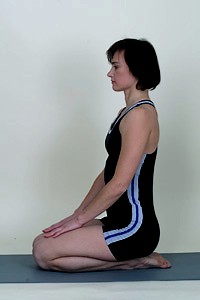The Meaning of Vajrasana
All yoga poses are named in Sanskrit, so is vajrasana; it can be translated into English as a “thunder pose” or “lightning bolt pose”, which comes from the name of demigod Indra’s weapon Vajra (a lightning bolt). Also this asana is sometimes called “a pose of a diamond hardness” or “indomitable position”, which relates to the final state of the pose.
Vajrasana Technique
First kneel and then sit on your heels, with your feet inverted (soles look upward). Lean forward slightly, with your hands pull your buttocks back and up, straighten your spine and shoulders, expand the chest, keeping your spine in an upright position. Now pull your spine upward to achieve the sensation of stretching of the spine and the space in the intervertebral joints.
 Place your palms on your hips of knees. It is possible to experience some slight pain or discomfort in knees, shins and ankles, but over time once you master it, this position will be one of the most enjoyable asanas.
Place your palms on your hips of knees. It is possible to experience some slight pain or discomfort in knees, shins and ankles, but over time once you master it, this position will be one of the most enjoyable asanas.
Fixation phase: you breathe freely, and remain in the asana as long as you like. It is a good asana for ashwini mudra practice. Uses of vajrasana also include simple breathing exercises, and the early stages of learning the contemplative techniques. Vajrasana is good for simple meditation. Vajrasana for beginners should be practiced three times a day.
Vajrasana Effects
This lightning bolt pose makes your legs’ muscles stronger, removes rheumatism and neuralgic pain in the legs.
There are uses of vajrasana for digestion: performing of the asana for half an hour immediately after a meal, combined with breathing through the right nostril, produces beneficial effects on the digestive process. It is also good for hair loss – anyone who practices this yoga pose from youth will not have gray hair till the old age.
Vajrasana Vs Virasana
These two asana look very similar, but the difference is in the position of the bottom: in vajrasana the bottom rests on heels, and in virasana the bottom sits on the floor. So, the degree of flexion of knees in virasana is greater than in vajrasana as well as stretchiness in the vastus parts of the Quadricep muscles. So you can start learning with vajrasana, and then try virasana.
Vajrasana during Pregnancy
In general practicing yoga in the first trimester is contra-indicated. While vajrasana is a simple pose, it is not recommended to remain in it for longer periods during pregnancy due to the reduced blood circulation in the legs. It can be the only disadvantage of the asana, I think. To help solve this problem you can use yoga blocks to keep the hips lifted and to lessen the flexion of the knees. Anyway, it is always better to consult with a doctor before you begin doing yoga in pregnancy.
I cannot speak of any vajrasana side effects, since there are no known ones, unless you do something completely wrong, or while being in an unfit condition (like the late pregnancy stages, etc.).
Vajrasana Chakra
While doing vajrasana you can focus your attention on svadhisthana chakra, the second from the bottom. There is a vajrasana modification called supta vajrasana, when you lean back, placing your head on the ground. In this pose you should concentrate on manipura chakra, which is located at the spine, behind the solar plexus.
I hope you will be able to do vajrasana yoga pose after this description. If you have questions or comments, please add them below.

what are thedisadvantages of vajrasana?is it affect on knees?how much time we can be in vajrasana after meal?
Hello, Anjali.
Well, if you do it correctly, there are no disadvantages, but there are some contraindications. Yes, if you have some knee injuries, you need to do it under the supervision of a yoga teacher. If you have a serious chronic disease or knee infections, consult your doctor. Contraindications include: Hypertension (high blood pressure), hyper function of an endocrine gland, sinusitis, weak cerebral vessels. Actually vajrasana can help in treating these conditions, but only if it’s done very gently, with attention and care, following the proper technique.